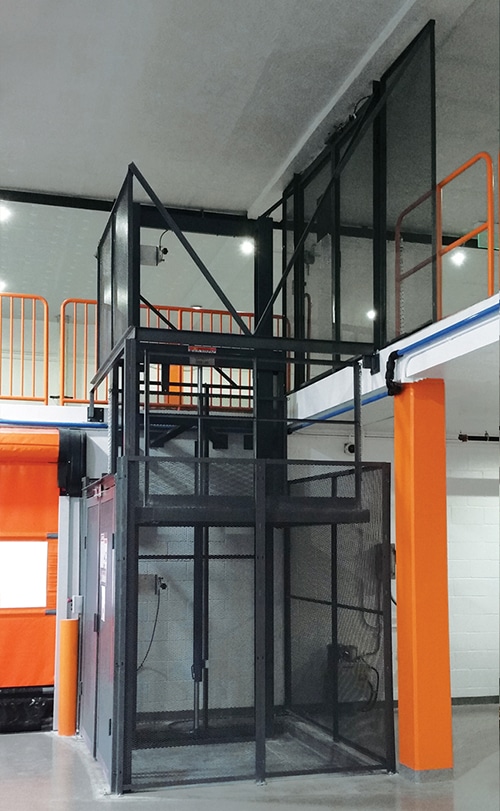
Micro fulfillment centers, which are small warehouses often located deep in crowded urban centers, allow direct-to-consumer retailers to get closer to their customers.
However, they also have logistical challenges not seen in traditional full-scale distribution centers.
Close to Home: Automating Micro Fulfillment Centers
Now, more than ever, shoppers are relying on e-commerce to get the products they need delivered directly to their doors.
Companies are shifting to direct-to-consumer models and offering rapid or even same-day fulfillment to meet unprecedented demand from this new breed of “stay-at-home consumers.”
Covering the “last mile” to reach these customers can be challenging—and is by far, the most expensive part of most supply chains. To lower this cost, suppliers are shifting goods out of giant distribution hubs and into smaller micro-fulfillment centers in cities and suburbs.
These last-mile distribution centers face unique challenges, including:
- Limited storage space
- High cost per square foot
- Repurposed or non-traditional locations
- A diverse mix of products
- Rapid inventory turnover
- Complex onsite operations (including the need for SLAM functionality)
To make the most of high-value storage real estate and fast-moving, dynamic workflows, most micro fulfillment centers rely heavily on automated material handling systems.
VRCs in Micro Fulfillment Centers
Repurposing retail facilities or other buildings for use as warehouse space puts unique demands on material handling equipment.
In fact, moving goods around spaces that were not designed for automated material handling processes would be impossible without a safe and reliable way to transfer loads between floor levels.
Vertical Reciprocating Conveyors (VRCs) were designed specifically to provide powerful, flexible lifting capabilities that can be installed in almost any space and integrated with a wide range of material handling technology and processes.
This has made VRC equipment a key part of the mix that powers small-scale automated warehouses. Here’s how:
Unlocking Vertical Space
VRCs are designed to provide all the functionality of a freight elevator without the complex regulatory requirements because VRCs are intended for the movement of materials only – not people. VRCs can lift loads of almost any weight or size to practically any height while serving an unlimited number of levels along the way, helping you access storage space you might have thought was unreachable.
Build Up – Not Out
Also called Mezzanine lifts, VRCs turn the unused “airspace” inside your facility into valuable warehousing square footage. Whether a single level or multiple stories, the flexible design of VRCs makes it possible to access this additional space quickly and efficiently.
Mezzanines also allow you to locate critical operational supplies close to space-constrained dock-level receiving and shipping areas.
Leverage Unused Areas
Have an unused elevator shaft? That makes the perfect home for a VRC. VRCs can also be designed to fit into spaces that are typically too small or do not comply with the code requirements for freight elevator installation, and they can lift more weight per square inch than a typical freight elevator.
Connect Through the Floor
VRCs can also be designed to provide vertical access where there was none before. PFlow can design a VRC for installation through floor levels.
Take It Outside
If you do not have the space for a VRC inside your facility, they can be installed on the exterior of your building, providing an alternative way to reach different floor levels with minimal structural changes to the interior of your facility.
Flexibility
VRCs are offered as either straddle, cantilever, or 4-post configurations. Each configuration has unique benefits and allows for varying load/unload patterns to accommodate your last-mile operational needs.
Integration Kingpin
VRCs provide reliable, repeatable lifting as needed. Their highly customizable design also allows them to be tied into existing conveyor systems or even integrated with automated or robotic picker systems.
The ability to connect automated systems on different levels makes VRCs an indispensable part of any multi-floor automated material handling system.
Automation Springboard
VRCs help to support the automation of other time-consuming, labor-intensive, or repetitive processes throughout your facility. Start by providing reliable, consistent lifting performance and use this as a springboard to tie in other processes like materials transfer or order picking.
Overcoming Challenges, Adding Value
It’s clear that VRCs offer distinct upfront advantages to specific challenges for small-scale warehouse automation. Now let’s consider how they offer at least partial solutions to some of the larger issues facing managers of micro fulfillment centers.
Let’s take a look at some of these and identify areas where VRCs can help to overcome challenges or add value.
1. Cost
Challenge: Smaller-scale warehouses often face budgetary constraints that may limit their ability to automate. They may need to consider how they can phase in automation over time.
Solution: Start your automation process with VRCs. By automating lifting, VRCs can provide immediate gains in efficiency and integration that can provide a platform for the next phase in your automation stack.
2. Space
Challenge: Smaller facilities, especially repurposed buildings, may lack the space required for robust conveyors or robotic systems.
Solution: VRCs can be designed to integrate into almost any space – even those where there is not enough room for elevators or forklifts – providing a safe and efficient way to transport goods between floor levels.
3. Maintenance
Challenge: Automated systems require continuous maintenance and support. Budget-constrained, smaller warehouses may not have the resources for on-staff maintenance techs or budget for third-party support for multiple OEM systems.
Solution: When properly maintained, VRCs can require less maintenance than other types of material handling equipment, like forklifts. PFlow offers scheduled maintenance programs training, safety inspections, and best-in-class support which takes the pressure off of on-site staff.
4. Complex Operations
Challenge: Small facilities need to cram the functionality of a full-scale distribution and operations center into a smaller footprint that includes the receiving, inventory-management, order-processing, and SLAM (Scan Label Apply Manifest) operations that make direct-to-consumer sales possible.
Solution: VRCs unlock access to extra storage space in your facility making mezzanine areas easily accessible in busy areas like the last 100 feet of your warehouse (SLAM). VRCs help you get more value out of the space you already have.
5. Scalability
Challenge: Smaller warehouses may not have the space or capacity to scale up as needed to meet increased demand or market growth, making it difficult to justify investment in allocating space for automated equipment at the facility.
Solution: VRCs can be installed to access unused storage space as needed, allowing capacity to be scaled with minimum disruption to your operations.
6. Return on Investment
Challenge: Smaller warehouses lack the capacity or economies of scale that allow investments in automation to pay for themselves in a timely and predictable way.
Solution: VRCs can help by increasing the scale and available capacity at a facility. In many cases, this can represent a step change rather than a marginal increase in efficiency and productivity for a set investment.
PFlow VRCs: Unlocking Big Value for Small Facilities
Whether you are looking to integrate VRCs into your existing material handling processes or you want to enable automation in your small multi-level warehouse, VRCs provide strong, effective, and reliable lifting capabilities plus flexible, customizable platform for increasing automation across your micro fulfillment center.
As the industry founder in 1977 and key author of state and federal codes, PFlow has literally written the book on VRC design and safety. Backed by the strength of the industry’s largest and most experienced dealer network, the largest in-house engineering and technical support staff, and dedicated in-region sales team, PFlow is industry’s trusted VRC partner. With over 20,000 units in operation, PFlow has the experience to ensure your project’s success.
Talk to us today about how we can develop and support an efficient, scalable, and affordable lifting solution for your business. You can also click below to learn more about how VRCs can raise the performance bar in even the most complex warehouse automation systems.
